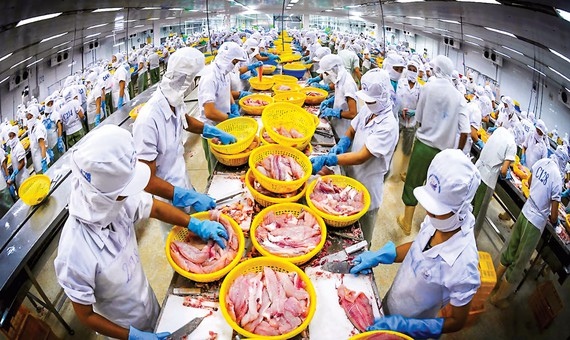China and USA main markets of Vietnamese goods
China and USA main markets of Vietnamese goods
China and USA are currently the two largest export markets for Vietnamese goods. However, some analysis points to worrying factors in these two markets, and questions remain whether these two vital export markets will continue to maintain their present position for Vietnamese export goods or not.
Illustrative photo. |
US market demand
According to the General Department of Customs, in 2021 Vietnam's exports to the US will reach USD 96.29 bn, up 24.9% compared to 2020. The world's largest economy continues to be Vietnam's largest export market when accounting for 28.6% of the country's turnover. In 2021, there will be 13 groups of goods exported to the US for a turnover of USD 1 bn or more, of which three groups will reach more than USD 10 bn. In 2021, wood and wood products brought in nearly USD 14.8 bn, with the US market alone accounting for nearly USD 9 bn, an increase of 24.6% compared to 2020, and accounting for 59.4% of Vietnam's total export of wood and wood products. Vietnam is currently the largest supplier to the US, accounting for about 40% of the total import value of furniture in the US.
Along with this, many key export groups of Vietnam have a large market share in the US market. The leather and footwear industry in the US is still Vietnam's largest import market. According to the Vietnam Leather, Footwear and Handbag Association, an American consumes about six pairs of footwear per year on an average, of which 1.3 pairs of footwear originate from Vietnam. In recent years, Vietnam's footwear exports to the US account for more than one-third of the total export turnover of the whole industry. For seafood, the US is also the largest market. In 2021, the seafood industry reached a turnover of USD 8.89 bn, of which the US market accounted for 23.1% of the total seafood export turnover of the country, reaching over USD 2.05 bn, up 26.2% compared to 2020.
In the first month of 2022, the US still holds the position of the largest export market for Vietnam, with an estimated turnover of USD 9 bn. However, the question that is being considered now is whether in 2022 Vietnamese goods will still be entering the US market in large quantities or not.
In a report titled "Looking Ahead at 2021", VinaCapital discusses US consumer demand for home use items such as televisions, laptops, and furniture, which are products that helped support manufacturing industries in Vietnam in 2021. According to this report, it is unlikely that the US will again impose strict Covid-19 blockades, and consumers in the US may not have to buy a large number of goods to use in a lockdown as happened in 2021. Therefore, the demand to buy expensive items such as televisions and computers in the US has dropped to a record low, which is not surprising.
Speaking with Saigon Investment, economist Nguyen Hoang Dung, said that the demand of the US market is still very large, and Vietnam's export products only account for a very modest market share there. Currently, many key export industries of Vietnam have orders until the end of the first and second quarters, and some businesses have even received orders until the third quarter, with most orders coming from the US market. Many industries have set export growth targets for the US market. For instance, this year wood and wood products could touch USD 10 bn to the US market. Mr. Dung feels that if there was no demand in the market, buyers would not have ordered goods from Vietnamese manufacturers.
Challenges in China
According to data of the General Department of Customs, two-way trade between Vietnam and China in 2021 reached USD 165.8 bn, up 24.6% compared to 2020. Of which, the export of goods to China reached nearly USD 56 bn, up 14.5%, and imports reached approximately USD 110 bn, up 30.5% compared to 2020. With this result, China continues to be the largest trading partner and the second largest export market for Vietnam after the US. China is currently a large export market for many products such as phones and components, especially agricultural, forestry, and fishery products. However, in 2021, many of Vietnam's export products have been severely affected by China’s zero Covid policy.
In 2021, seafood was one of the industries that was clearly affected by the Chinese market. The Vietnam Association of Seafood Exporters and Producers (VASEP) assessed that China's implementation of the zero Covid policy, and tightening of inspections to trace the SARS-CoV-2 virus on imported seafood products, caused trade and customs clearance problems. According to statistics, in 2021, seafood export turnover to China was only USD 1.1 bn, down 17% compared to 2020. This was the lowest level in the last five years.
Assessing the main products exported to China in 2022, Mr. Truong Dinh Hoe, General Secretary of VASEP, acknowledged that China may still retain its position as the largest pangasius import market for Vietnam. Currently, many Chinese importers say that pangasius stockpiles until the summer of 2022 have been exhausted, so they expect the government to relax goods inspection measures to increase purchases. Vietnam is still one of the top three suppliers of fish products to China and Hong Kong, especially for the exclusive supply of frozen pangasius to China. This is also one of the great advantages of Vietnamese pangasius.
Fresh vegetables have also been affected when exporting to China in the last year. If in previous years, the market shares of fruit and vegetable exports to China account for 70%, now it is just over 50%. However, it still is the largest market for Vietnamese fruits and vegetables. In 2021, fruit and vegetable exports reached USD 3.55 bn, up by 8.6% compared to 2020, of which exports to China reached USD 1.9 bn, accounting for 53.7% of the total export turnover. So far it looks like the No. 1 position will definitely be held by China for the export of Vietnamese goods in 2022.






















